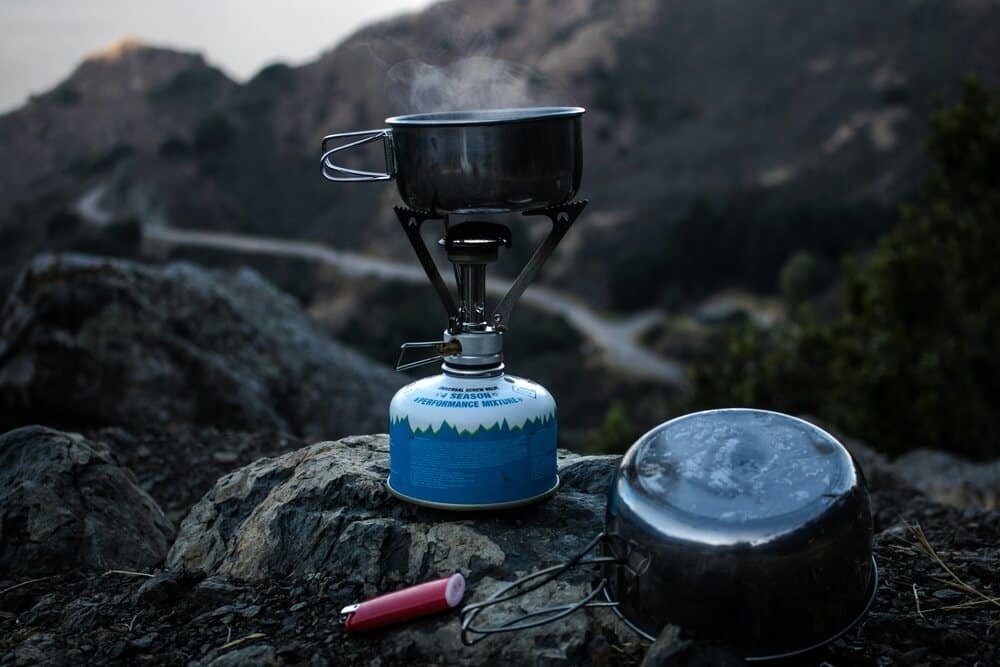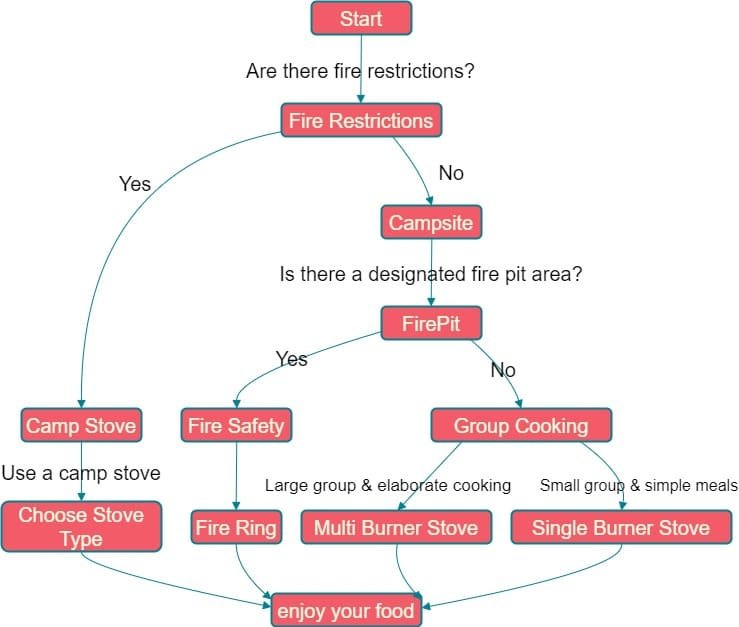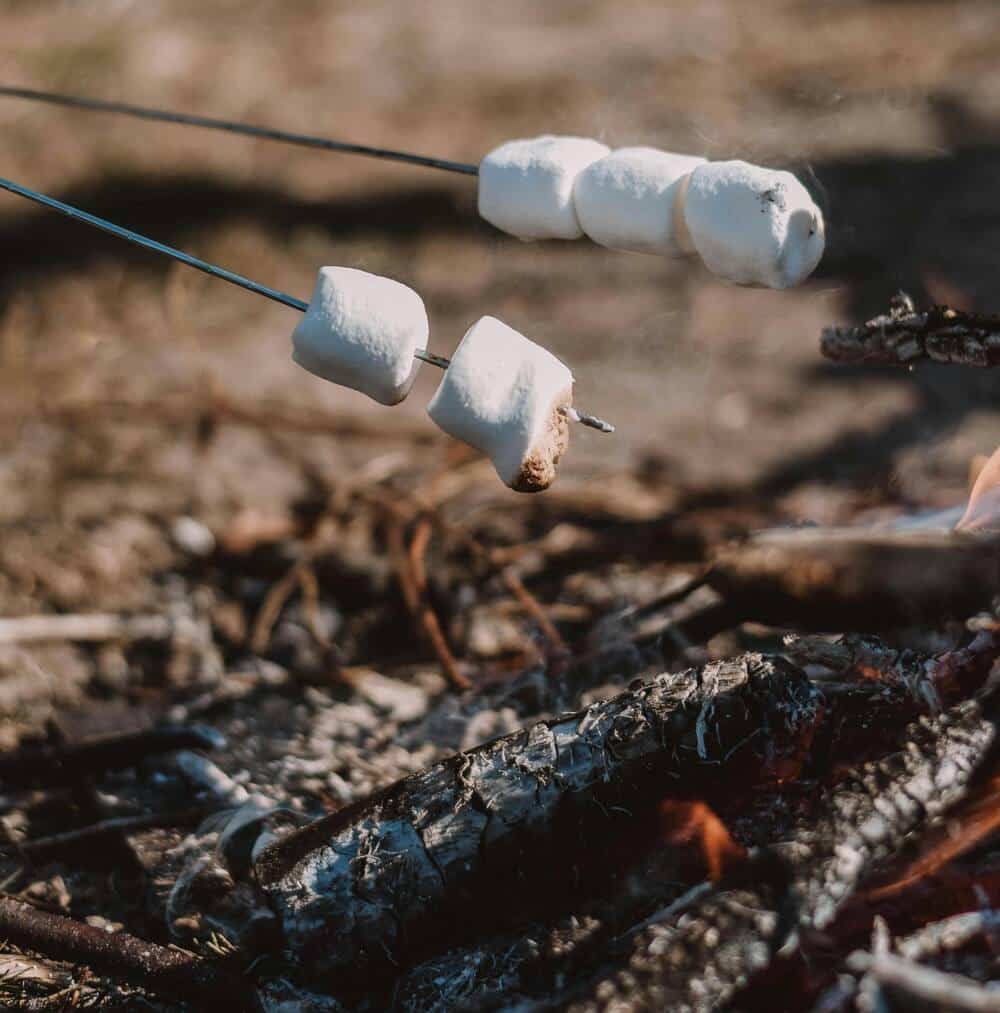Sitting around a campsite and toasting marshmallows on a roaring fire is an age-old tradition. Fire has been essential for our survival, dating back to our prehistoric relatives. A campfire symbolizes comfort and safety. As a new camper you may be itching to build your first fire.
However, it isn’t the best option in a dry environment. Intense campfire heat affects soil fertility and water-holding ability. It is hard to adhere to Leave No Trace principles as well. You may only be able to minimize the campfires impact. The National Park Services discusses the dangers associated with campfires in dry conditions.
You can master fire techniques for dry environments by learning how to use lightweight stoves, natural fire rings, fire pans and mound fires. These alternative fire methods leave a smaller footprint and you adhere to Leave No Trace principles.
Why do we need alternative fire methods in dry environments?
No doubt you watch the news on occasions. Summer wildfires are getting worse. Unfortunately, the romantic picture of a crackling campfire hides some harsh realities. Bone dry conditions increase wildfire risk. Just one spark can turn a forest into a raging inferno. This poses a threat to lives, property and a fragile ecosystem.
The Dangers of Fire in Dry Environments
Low Moisture Content – Any dry vegetation will act as kindling, it’ll ignite easily and spread flames rapidly.
Strong winds – Fire loves wind. Embers will become flames and escalate a barely lit fire into a major wildfire.
Limited Resources – Water is often scarce in dry areas. Controlling a fire is extremely difficult in this environment.
Remember, Leave No Trace principles and fire safety go hand in hand. Many places in July and August have restrictions on open campfires and only allow cooking stoves and gas grills. Make sure you know the fire restrictions before heading to the campsite.
So,alternative fire methods are the answer. Now you know the heightened fire danger in a dry campsite, let’s explore some viable options that are safer ways to experience the warmth and ambiance of a fire.
Camp Stoves for Dry Environments – The Reliable Option
Camp stoves are the go-to option when there are fire restrictions or when the campsite is sunbaked and dry. They provide a safe and enjoyable camp cooking experience. There are plenty of advantages when compared to a traditional campfire.
Camp Stove Benefits
Portability – Camp stoves are lightweight and compact, they’ll easily fit in a backpack and are easy to carry.
Efficiency – A good camp stove converts fuel to heat extremely effectively. Cooking time is quicker and less fuel is used compared to an open fire.
Minimal Impact – In contrast to campfires, camp stoves leave a small footprint on the environment. You aren’t required to dig a fire pit or disturb the surrounding nature.
Camp Stove Fueling
There are two popular types of camp stove fuels. Let’s look at the advantages and disadvantages.
Canister Fuel
Pros – Burns clean, is easy to use (screw-on canisters), available everywhere, and stores well. Best for newbie campers.
Cons – Can be more expensive than other cheaper fuel options, performance can be affected by the cold.
Liquid Fuel –
Pros – Generally cheaper than canister fuel, a more extensive range of stove options available, and works well in all weather conditions.
Cons – More challenging to use (requires priming), can be trickier to light and maintain, proper storage and disposal of the fuel is required.
There are other types of stoves and fuels available, you may want to investigate them in the future. Canister camping stoves are a great start for new campers.
Choosing the Right Camp Stove for You

Picking the correct camp stove will depend your camping needs
Group Size – If you are taking a solo trip or are part of a small group, a single-burner stove is fine. For larger groups, a double-burner will be faster and more efficient for cooking.
Cooking Style – Do you plan on cooking elaborate meals? A stove with an adjustable burner is vital. For basic boiling and frying, a basic single-burner will suffice.
Weight and Size – Backpackers should choose a lightweight, compact stove. For car camping, weight won’t be the same concern, why not go for a sturdier, multi-burner option.
Safe Camp Stove Operation
- Always follow the manufacturer’s instructions, be safe not sorry.
- Find a level, stable surface to use your new camp stove.
- Keep away from other flammable materials.
- Never use a stove inside a tent or enclosed area. (You’ll find mixed opinions online, but I just don’t feel safe doing it)
- Be mindful of wind, adjust the flame accordingly.
- Have proper ventilation when cooking to avoid carbon monoxide poisoning.
Keeping Your Footprint Small
Use a fuel can stabilizer under your stove. This will stop your stove from toppling over.
Set up a designated cooking area away from dry flammable vegetation. Give yourself some space, clear away any debris.
Pack out all leftover food and stove remnants, this will keep you in line with No Trace Principles.
Understand the benefits of camp stoves, choose the right fuel and model that suits your needs, and practice safety first. You’ll have a reliable and responsible cooking solution for camping in dry environments.
Some places will allow for small, contained fires. So next, we’ll explore alternative fire containment methods.
Natural Fire Rings (Caution)
The camp stove is the safe and reliable option, but there is something charming about a crackling campfire under a clear night sky. However, using natural fire rings comes with a set of considerations, especially when the environment is dry.
The Problem of Natural Fire Rings
Environmental Impact – Constructing fire rings can disturb the natural environment. Removing rocks disrupts vegetation and leaves lasting scars on the landscape, no matter how careful you are.
Fire Safety Concerns – Natural fire rings, unlike designated fire pits, may lack proper containment. It only takes an ember or two to escape and ignite the surrounding dry vegetation. A poorly constructed fire ring could increase the risk of fire spreading.
Use with Caution
So now you know the downsides, proceed with caution. Natural fire rings should only be used in designated areas provided by campgrounds. Things to consider:
- Do fire restrictions allow for small, contained fires? Alway check local fire restrictions before starting.
- A designated fire pit is unavailable. In rare cases, there might not be a campsite with a designated fire pit, if so you’ll have to come up with another plan.
- You know what you are doing. You have experience and know how to build and maintain a safe fire. If you are a new camper stick with a camping stove.
Building a Small, Temporary Fire Ring (Minimize Impact)
If your only option is a natural fire ring, prioritize minimizing your impact on the environment. Here is how to construct a small and temporary fire ring:
Collect Loose Rocks – Look for loose rocks close to the campsite, don’t dig up rocks that are surrounded by vegetation. Leave the natural structure of the environment intact.
Size Matters – Keep your fire ring small. 30-36 inches is ideal. A smaller fire requires less wood and the risk of embers escaping decreases.
Single-Layer Construction – Create a single layer of rocks to form a perimeter around your fire pit. Avoid building a tall structure. You don’t want to trap heat and increase the risk of igniting the surrounding vegetation.
Remember – Even with a small temporary fire ring, make safety your priority. Clear a generous space around the fire. Remove any flammable materials such as twigs, leaves, and branches. Keep a bucket of water or sand on hand to extinguish the fire completely. Never leave a fire smoldering.
Natural fire rings are possible in limited situations, but be safe and limit your impact on the environment. In the next section, we’ll explore alternative fire containment methods that are safe and more responsible.
Fire Blankets and Alternative Fire Containment
Fire safety is vital in dry environments. You must be able to contain your fire. Consider the following equipment, you don’t want to be winging it.
Fire Blankets – Portable, fire-resistant blankets help smother flames quickly. They minimize escape and wildfire risk. They are small enough to fit in a backpack.
Metal Fire pits – Elevated pits help you build a safe and contained fire. Check to see if they have mesh sides for ventilation.
Fire Pit mats – It’s important to protect the ground from any heat damage. A heavy-duty, heat-resistant fire mat will do this.
The best option will depend on your needs and the campsite rules. Choose fire blankets for their versatility, while pans and mats are great for a more contained fire.
Remember – Check the campsite fire restrictions and make safety your number one concern. Never leave a fire unattended, clear an area to create a flammable free zone, and extinguish completely before leaving. These alternatives will help you enjoy a safe and responsible fire while keeping the place almost like you found it.
Making the Right Choice: A Decision-Making Guide

Leave No Trace Principles in Action – Responsible Fire Use
Leave No Trace (LNT) principles should be the cornerstone of any responsible outdoor recreation. In this article, I’ve emphasized focusing on safety and minimizing the environmental impact when using a fire. Read Principle 5 minimize campfire impacts of the LNT principles.
Remember LNT principles are more than just about fire use. Practice good waste disposal, minimize your impact on vegetation, and respect the wildlife. Following these simple guidelines virtually guarantees you’ll leave no trace behind. Future campers will be able to enjoy the same immaculate environment. Do things right and you’ll have a fun and fulfilling camping experience.
Conclusion – Enjoying Campfires in Dry Environments, the right way
Campfires are part of our history and a great way to connect with nature. People have been building fires for a long time. However, fire safety is paramount, especially in our hot and dry summers. We looked at alternative methods, highlighting their benefits and responsible use.
Key Takeaways:
- Fire Safety First: Always prioritize fire safety by checking local restrictions, using designated fire pits if available, and practicing proper fire-building and extinguishing techniques.
- Alternative Fire Options: Camp stoves offer the safest and most reliable option, while fire blankets and fire pans provide containment for contained fires in permitted situations.
- Leave No Trace: Following Leave No Trace principles ensures minimal environmental impact. Practice proper fire extinguishing, correctly dispose of leftover materials, and please respect the natural environment.
Be Prepared, Be Responsible: By prioritizing safety, using alternative fire methods responsibly, and following LNT principles, you will enjoy a campfire experience that minimizes risk and protects the environment.
Do you have any questions about fire safety or alternative fire methods in dry environments? Share this article with your fellow campers, and let’s discuss responsible fire use in the comments below!
Articles and Resources
For more information on fire safety and responsible campfire use, visit the websites of the National Fire Protection Association (NFPA)
(https://www.nfpa.org/downloadable-resources/safety-tip-sheets/campfire-safety-tip-sheet)
The Western Fire Chiefs Association has some great tips.
(https://wfca.com/wildfire-articles/campfire-safety-tips/)
Learn more about Leave No Trace principles and how to minimize your impact on the outdoors at https://lnt.org/about/.
If you’re considering purchasing a camp stove, check out https://www.outdoorgearlab.com/topics/camping-and-hiking/best-backpacking-stove for in-depth reviews on different stove models.


Pingback: Campground Etiquette: How to Be the Best Campsite Neighbor - novus places
Pingback: Can you camp along the Colorado River?